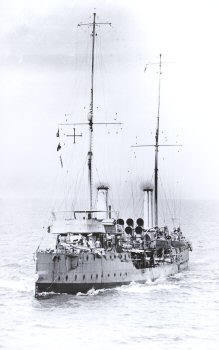Mediterranean service
Harrier's first commission was spent on the Mediterranean Station. She deployed to Crete in February 1897 to operate as part of the International Squadron, a multinational force made up of ships of the Austro-Hungarian Navy, French Navy, Imperial German Navy, Italian Royal Navy ( Regia Marina ), Imperial Russian Navy, and Royal Navy that intervened in the 1897-1898 Greek uprising on Crete against rule by the Ottoman Empire. On 21 February 1897, she joined the British battleship HMS Revenge and torpedo gunboat HMS Dryad, the Russian battleship Imperator Aleksandr II, the Austro-Hungarian armored cruiser SMS Kaiserin und Königin Maria Theresia, and the German protected cruiser SMS Kaiserin Augusta in the International Squadron's first direct offensive action, a brief bombardment of Cretan insurgent positions on the heights east of Canea (now Chania) after the insurgents refused the squadron′s order to take down a Greek flag they had raised. [3] [4]
Lieutenant Commander Philip Walter was appointed in command in July 1897. She left Port Said for Malta on 8 February 1900, [5] arrived at Plymouth on 1 March, [6] and on 24 March 1900 paid off at Devonport, [7] where she was placed in the B division of the Fleet Reserve. Commander Cyril Everard Tower was appointed in command on 11 March 1901, following which she again returned to the Mediterranean Station, [8] and in late November 1901 replaced the Mariner-class gunvessel Melita as the special service vessel at Constantinople. [9] She visited the Danube in early 1902, and was ordered to the Persian Gulf on special service in June that year. [10] After a brief visit to the Mediterranean in September for combined manoeuvres off Nauplia, [11] she was back in the Gulf visiting Aden and Perim the following month, [12] then Hodeida in December. [13]


